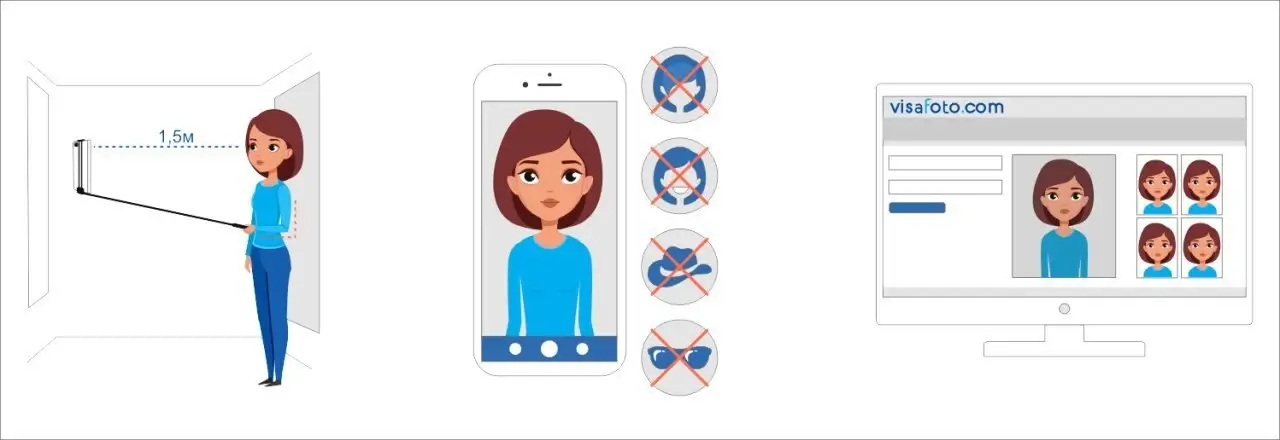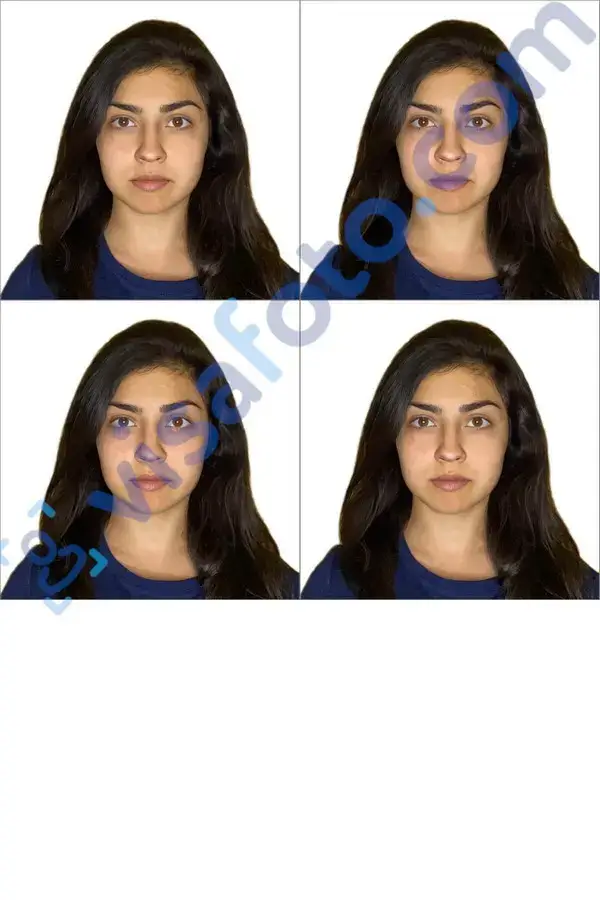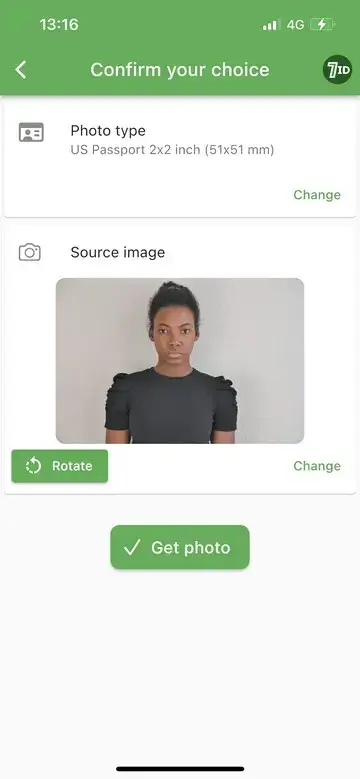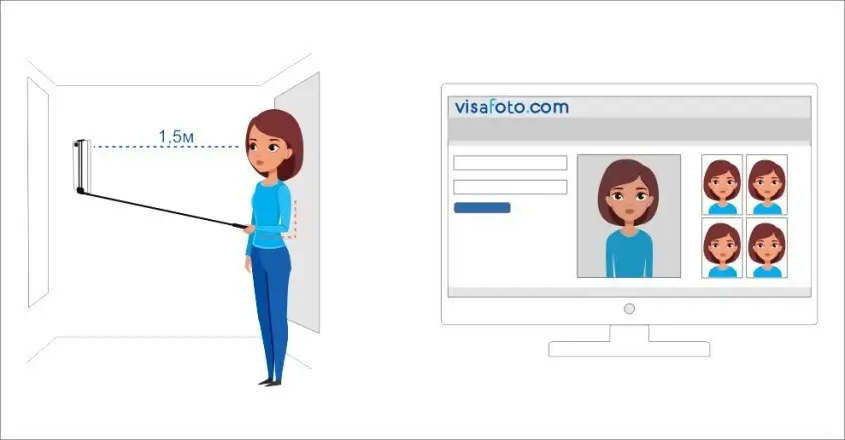Is It Worth Getting a U.S. Passport Card If You Already Have a Passport Book?

Many Americans hold a valid passport book but feel unsure whether the passport card offers any real advantage. They wonder, “Which is better, a passport card or a passport book?” or “What's the difference between a passport book and a passport card, and do I need both?”

This guide answers these questions and more. It also explains when the passport card adds practical value and when it doesn’t.
Table of contents
- What is a U.S. Passport Card?
- What's the Difference between a US Passport Book and a US Passport Card?
- Benefits of Having Both
- When the Passport Card is Not Worth It
- How to Apply for a U.S. Passport Card
- Documents Required for the US Passport Card Application
- Get a Photo for Your Passport Card Application Online!
- U.S. Passport Photo App
- Passport Card Application Fees
- Common Passport Card Application Use Cases
- FAQ
What is a U.S. Passport Card?
A U.S. passport card is a compact, plastic ID issued by the U.S. Department of State for American citizens. It confirms both citizenship and identity. This card is valid for 10 years for adults and 5 years for children under 16. It features advanced security, including an RFID chip, to speed up border crossings. Additionally, it acts as a REAL ID-compliant document for domestic flights and entry into federal facilities.
The passport card is designed for travel by land or sea to Canada, Mexico, Bermuda, and select Caribbean nations. However, it is not suitable for international air travel.
This card is a cost-effective and portable alternative to the passport book, ideal for frequent or regional travelers crossing borders by land or sea.
Do I need both a passport book and a card to travel internationally? No, just the passport book is necessary for international travel. The card is an optional addition for specific land and sea travel near the U.S.
What's the Difference between a US Passport Book and a US Passport Card?
Are the passport book and the passport card the same? No, the two documents serve different travel needs, and understanding these differences helps you decide whether the card adds real value. Here you’ll see how they compare in terms of travel permissions, format, and everyday use.
Passport card vs. passport booklet
Passport book:
- Grants access for international travel by air, land, or sea anywhere globally.
- Includes pages for stamps and visas required by various countries.
- Can be used for domestic flights and meets REAL ID standards in the U.S.
- Typically more costly than the passport card.
Passport card:
- Allows travel by land and sea to Canada, Mexico, Bermuda, and certain Caribbean areas.
- Not valid for international air travel; unsuitable for flying abroad.
- Wallet-sized and more affordable than a passport book.
- Lacks pages for visas and cannot be stamped by foreign governments.
- REAL ID-compliant for U.S. domestic flights and entry to federal facilities.
Should I get a passport book or a passport card? Opt for a passport book if you plan to fly internationally or visit destinations beyond North America and the Caribbean. A passport card works for land and sea crossings to those specific regions.
Benefits of Having Both
Do I need to get both a passport book and a card? You are not required to obtain both. The passport book alone is adequate for all travel types, but the card can serve as a convenient, affordable backup for eligible land and sea crossings. However, some travelers gain practical advantages from owning both documents, especially if they frequently cross land or sea borders. Here we outline situations where the card complements the passport book and offers extra convenience.
- Ease of travel. The card is compact and convenient for regular trips to Canada, Mexico, Bermuda, and the Caribbean. It allows you to safely store your passport book and reserve it for air travel.
- Backup and security. If you lose one document, the other acts as a backup proof of citizenship, which is invaluable in emergencies or when applying for replacements.
- REAL ID compliance. Both documents meet REAL ID standards, suitable for domestic flights and access to federal facilities. The card is especially useful if you lack a compliant state driver’s license.
- Cost-effective. Applying for both simultaneously reduces costs since you only pay the acceptance fee once. The passport card is an economical addition.
- Privacy and everyday use. Use the card as a secure ID in everyday situations where you don’t want to carry your passport book, like visiting bars or banks. The card maintains privacy by not displaying your address, unlike some state IDs.
- Efficient border crossing. The RFID chip in the passport card ensures swift processing at land borders, enhancing re-entry speed into the U.S. by car or boat.
When the Passport Card is Not Worth It
For many applicants, the card brings little or no added benefit. Below, we identify the cases where the card doesn’t improve your travel experience and may simply add unnecessary cost.
- International air travel. The card is not valid for international flights, making it irrelevant for overseas trips or flights to any foreign country.
- Travel outside North America. The card is limited to land or sea entry into about 20 countries. For regions beyond this, it's ineffective.
- Emergencies. In emergencies during cruises or land travel, if you need to fly home, the card won’t suffice, which could leave you stranded.
- Redundant identification. If you already possess valid IDs and a passport book, the card might add complexity. Many official uses prefer a driver's license or state ID.
- Limited value for infrequent travelers. If you seldom travel or mainly fly internationally, the card doesn’t provide significant benefits over the passport book.
How to Apply for a U.S. Passport Card
Applying for the card follows the same basic structure as applying for a passport book, but with a few key distinctions. Here you’ll learn the steps involved, whether you’re a first-time applicant or renewing.
- First-time applicants or those ineligible for mail renewal should complete Form DS-11. You can complete the DS-11 Form online and print. Here are the detailed DS-11 instructions.
- Gather all necessary documents, as outlined in the guide.
- Pay the application fee to the U.S. Department of State and a separate execution fee to the acceptance facility. Ensure these fees are separate. Verify payment methods with your chosen facility.
- Visit a passport acceptance facility, such as specific post offices, libraries, or clerk offices. An agent will validate your documents, witness your signature, and submit your application for processing.
Eligible renewals by mail should use Form DS-82. Include your most recent passport, documentation for any name changes, a new photo, and the required fees. Mail renewals do not require an execution fee.
Routine processing typically takes 4–6 weeks. Expedited service is available for an extra fee and usually completes within 2–3 weeks.
Do the passport book and passport card come together? Although you can apply for both at once, they are separate documents and are issued individually.
Documents Required for the US Passport Card Application
The application process requires proof of identity and citizenship, along with supporting documents for first-time applicants. Here's what you need:
- Completed application form:
- Form DS-11 for first-time applicants or those who cannot renew by mail.
- Form DS-82 for eligible renewals.
- Proof of U.S. Citizenship (bring original and photocopy on white paper):
- Certified U.S. birth certificate with full name, birth details, filing date, registrar’s signature, seal, and parents’ names.
- Previous U.S. passport (current or expired).
- Original U.S. Naturalization Certificate or Certificate of Citizenship.
- Consular Report of Birth Abroad (CRBA).
- Proof of Identity (bring original and photocopy):
- Valid driver’s license, state ID, or government/military ID.
- Previous U.S. passport book or card.
- Certificate of Naturalization or official government employee ID.
- One recent U.S. passport-sized color photo (2 × 2 inches).
- Separate payments for application and acceptance/execution fees.
- Include your Social Security Number (SSN) on the application form.
Additional documentation may be necessary for minors and specific situations such as adoptions, derivative citizenship, or parental consent.
Get a Photo for Your Passport Card Application Online!
For a hassle-free way to get a compliant passport card photo, use online professional services like Visafoto.com. With a 99.7% approval rate, Visafoto has provided expert photo editing for passports, visas, and other documents globally since 2013.
Simply take a photo in natural light with your smartphone or digital camera and upload it to Visafoto.com. The service will take care of background removal, resolution adjustment, color correction, and sizing to meet official requirements.
Example of a picture you can provide:

Once processed, you'll receive a digital file perfect for online submissions and a version ready for printing. If you're unsatisfied, you'll get a free redo. Additionally, if officials reject your photo, we offer a full refund.


U.S. Passport Photo App



For those who prefer using a smartphone, try the 7ID app from Visafoto.com. This easy-to-use app simplifies creating ID, passport, and visa photos and works on both iPhone and Android.
Upload your photo to the 7ID app, select your document type and country, and the app will automatically align your photo to official standards, adjusting size, format, background color, and ensuring proper facial and eye alignment. You'll receive a digital file and a print-ready template suitable for standard paper sizes like 4×6, A4, A5, or B5.
If you have questions, our technical support team is available 24/7 to assist you.
Passport Card Application Fees
The card comes with its own fee schedule, which differs slightly from the passport book costs. Here you’ll find a clear breakdown of what you’ll pay depending on your age and application type.
Passport card costs are as follows:
- Application fee (paid to the U.S. Department of State): USD 30.
- Execution fee (paid to the acceptance facility): USD 35.
- Total fee for first-time applicants: USD 65.
Additional options:
- Expedited processing fee: USD 60 to speed up processing to 2–3 weeks.
- 1–2-day delivery: only available for passport books, not cards.
Combined passport book and card fees:
- Application fee: USD 160.
- Execution fee: USD 35.
- Total for first-time applicants applying for both: USD 195.
If you already possess a valid passport book, and you're only applying for a passport card, you only pay the USD 30 application fee with no execution fee.
What's the difference in cost between a passport book and a passport card?
- Passport book: USD 130 application fee plus a USD 35 acceptance fee, totaling USD 165 for first-time adult applicants.
- Passport card: USD 30 application fee plus a USD 35 acceptance fee, totaling USD 65 for first-time adult applicants.
Common Passport Card Application Use Cases
Common use cases for a U.S. passport card include travel, identification, and compliance with REAL ID requirements, particularly for those who travel frequently within North America or need a secondary, government-issued ID. Here are the most typical scenarios where Americans find the card useful:
- Land and sea travel: ideal for U.S. citizens traveling by land or sea to Canada, Mexico, Bermuda, and the Caribbean. While it's not valid for international air travel, it's perfect for road trips, cruises, or short getaways.
- Domestic flight ID: as a REAL ID-compliant document starting in 2025, the card is accepted for TSA security checks at domestic airports, especially useful if your driver's license isn't REAL ID-compliant.
- Citizenship and Government ID: the card serves as primary proof of U.S. citizenship for government, banking, or workplace ID checks and can be used with Form I-9 for employment verification.
- Everyday second ID: conveniently fits in your wallet, providing a backup government-issued ID for opening bank accounts, accessing age-restricted venues, or when you prefer not to carry your passport book.
- Passport book backup: many travelers keep both a passport book and card, staggering their expiration dates to ensure a valid ID is always available in case one is lost or being renewed.
- Facility and base access: grants entry to federal facilities and military bases, which is beneficial for military families or those requiring frequent secure facility access.
- Cruise ship ID: perfect for secure off-ship identification while keeping the passport book safely onboard during excursions.
FAQ
Are the passport book and the passport card the same number?
No, each has its own unique number, even if issued at the same time.
Can you fly with a U.S. passport card?
You can't use it for international flights, but it is valid for domestic air travel within the U.S. as a REAL ID-compliant document.
Is it cheaper to get both the passport book and card together?
Yes, obtaining both together costs less. The combined application fee is $160 (with a $35 execution fee), saving you $5 versus applying separately.
What information is printed on the passport card?
It includes your name, photo, date and place of birth, sex, card number (starting with “C”), nationality, issue and expiration dates, and issuing authority. It also has a ghost photo, a signature, and an RFID chip for border crossing.
Do I need a passport book and card to go to Mexico?
No, for travel to Mexico by land or sea, you can use either the passport book or card. However, flying requires a passport book.
Does the card have the same validity as the passport book?
Yes, both are valid for 10 years for adults and 5 years for children under 16.
